Презентация lecture 13. microbe and disease. immune system

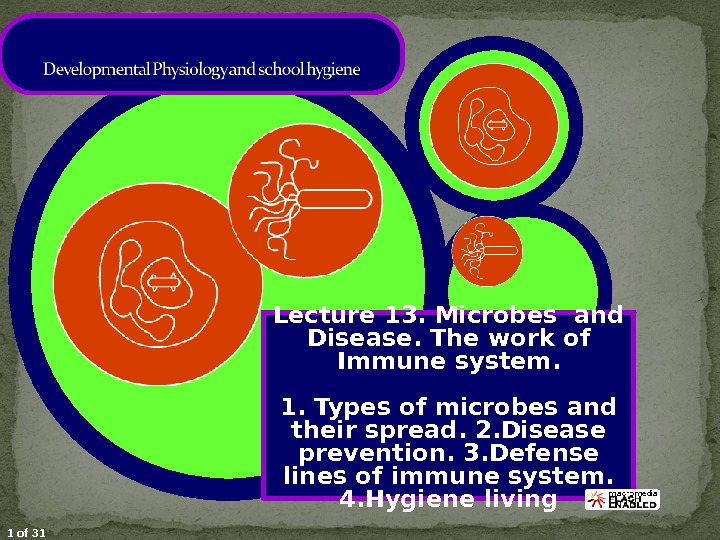

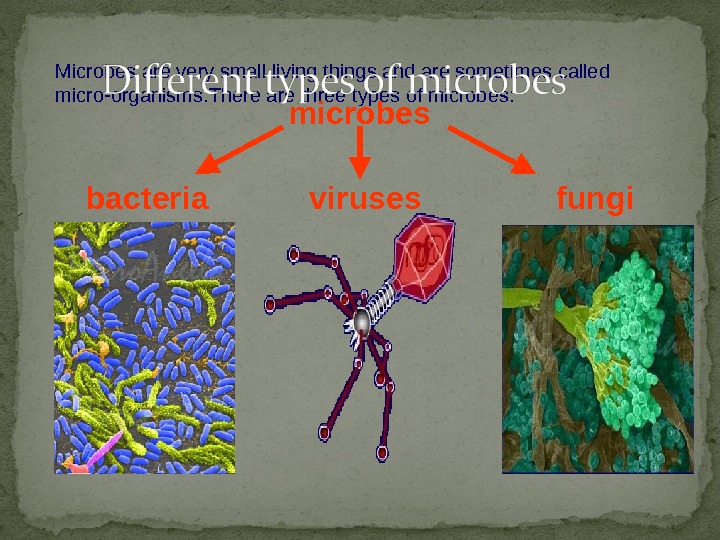



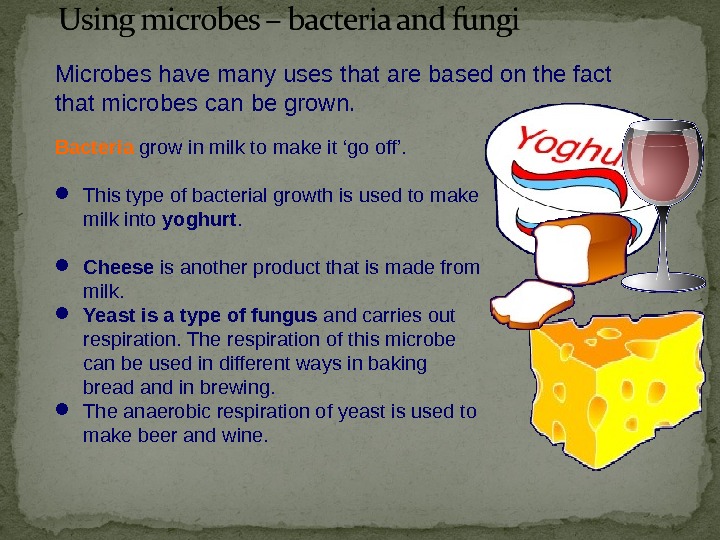
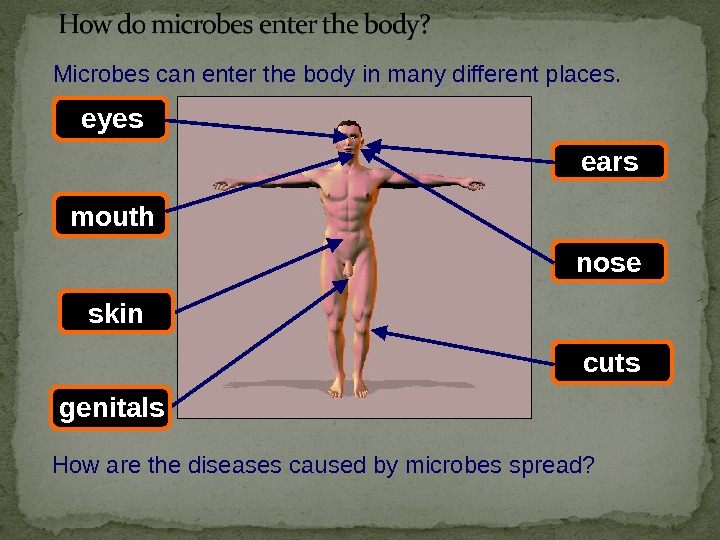
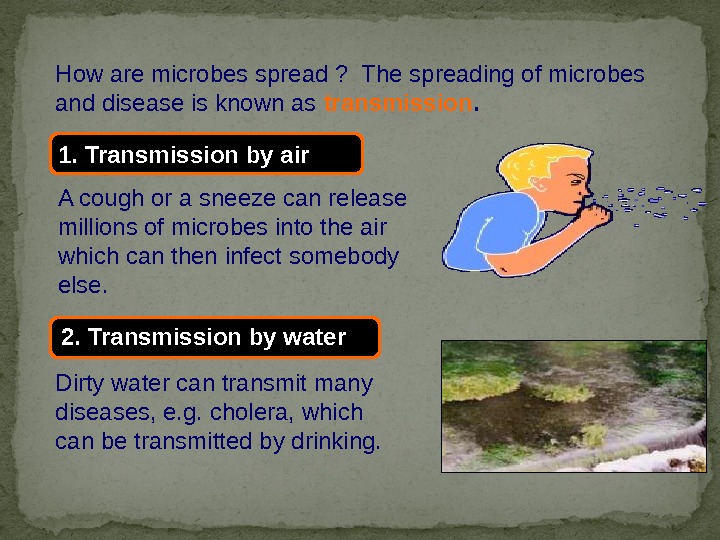



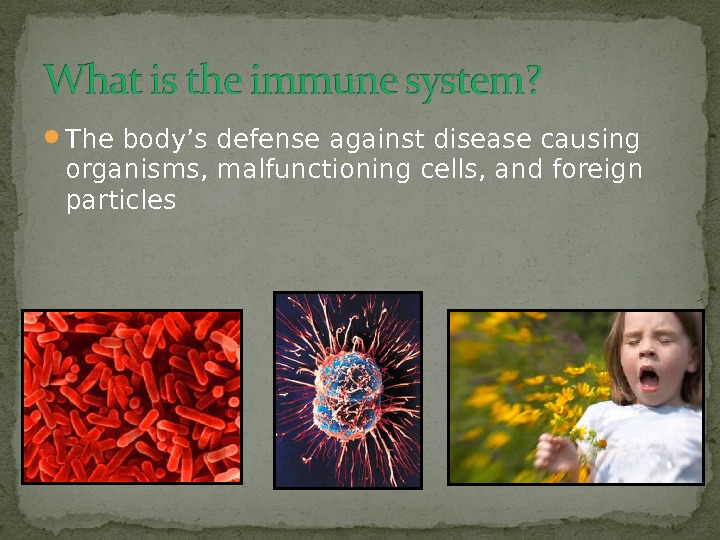


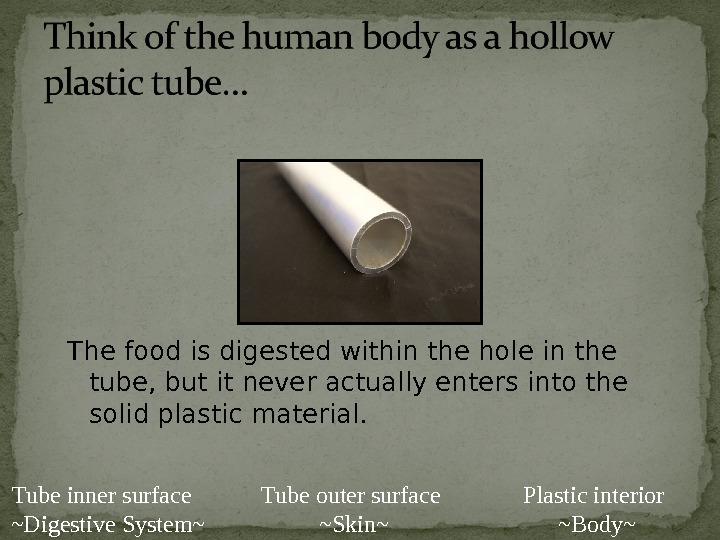
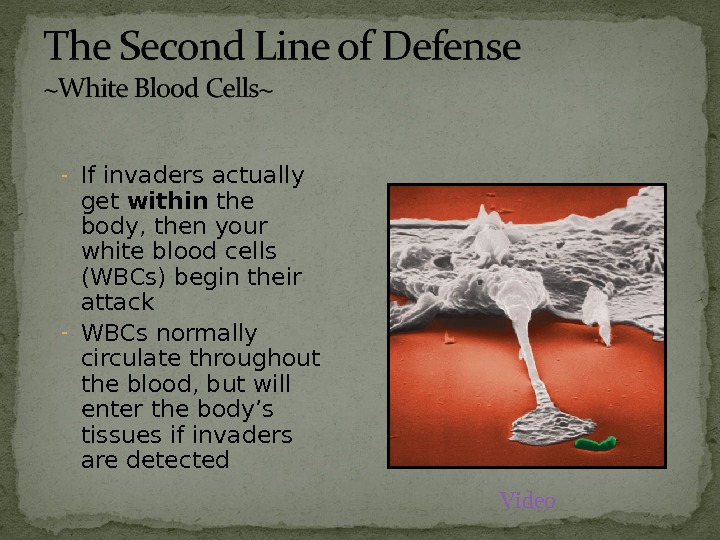




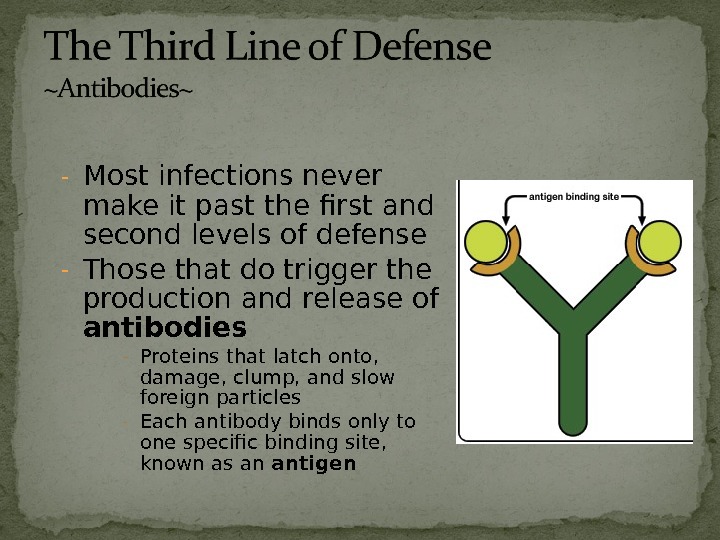

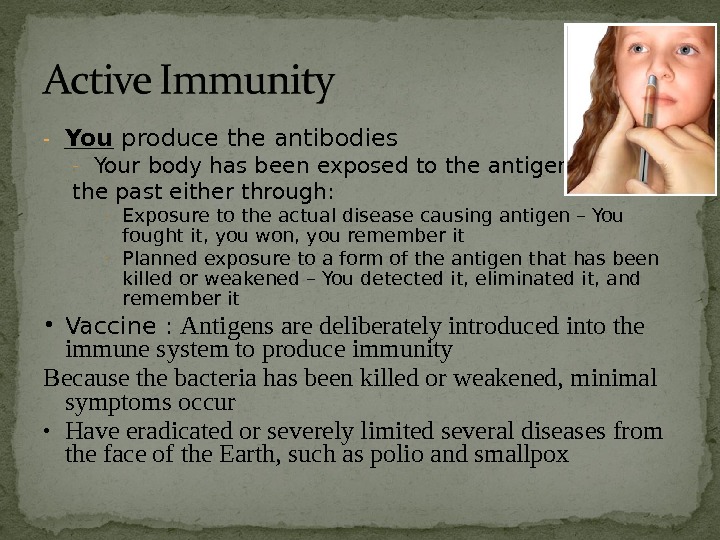
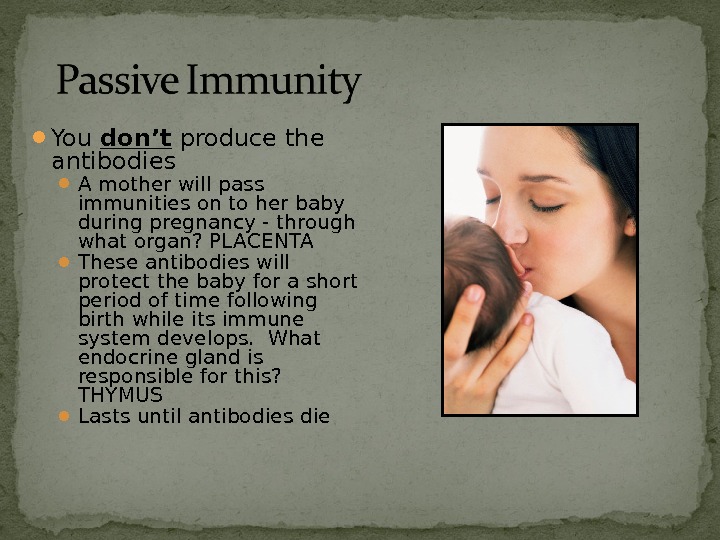

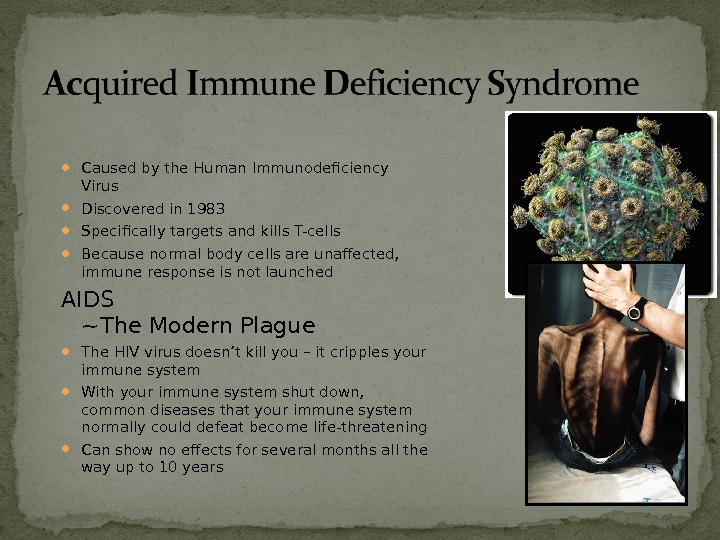



lecture_13._microbe_and_disease._immune_system.ppt
- Размер: 6.6 Mегабайта
- Количество слайдов: 30
Описание презентации Презентация lecture 13. microbe and disease. immune system по слайдам
 1 of 31 Lecture 13. Microbes and Disease. The work of Immune system. 1. Types of microbes and their spread. 2. Disease prevention. 3. Defense lines of immune system. 4. Hygiene living
1 of 31 Lecture 13. Microbes and Disease. The work of Immune system. 1. Types of microbes and their spread. 2. Disease prevention. 3. Defense lines of immune system. 4. Hygiene living
 antibiotics – Chemicals prescribed as medicine to kill bacteria inside the body. antibodies – Chemicals produced by white blood cells to fight microbes that cause disease. bacteria – The type of microbes that are single-celled organisms. fungi – The type of microbes that feed off other living things. immune – Resistance to infection caused by a microbe – A very small living thing. transmission – The spread of a disease from person to person. viruses – The type of microbes that can only grow and reproduce within other living things.
antibiotics – Chemicals prescribed as medicine to kill bacteria inside the body. antibodies – Chemicals produced by white blood cells to fight microbes that cause disease. bacteria – The type of microbes that are single-celled organisms. fungi – The type of microbes that feed off other living things. immune – Resistance to infection caused by a microbe – A very small living thing. transmission – The spread of a disease from person to person. viruses – The type of microbes that can only grow and reproduce within other living things.
 Microbes are very small living things and are sometimes called micro-organisms. There are three types of microbes: bacteria viruses fungimicrobes
Microbes are very small living things and are sometimes called micro-organisms. There are three types of microbes: bacteria viruses fungimicrobes
 size: 1/1000 mm shape: Bacteria can be spherical, rod-shaped or comma-shaped. structure: Bacteria are single-celled organisms, which do not completely have a nucleus. Some cause disease, but many are useful. reproduction: Bacteria reproduce very quickly. Two can very quickly become four, then eight and so on. The time of reproduction depends on how desirable the conditions are. Bacteria can rapidly reproduce themselves in warm, dark, and moist conditions Some can reproduce every 20 minutes Example: flu, measles, chickenpox, smallpox. Bacteria e. g. Salmonella and Streptococcus
size: 1/1000 mm shape: Bacteria can be spherical, rod-shaped or comma-shaped. structure: Bacteria are single-celled organisms, which do not completely have a nucleus. Some cause disease, but many are useful. reproduction: Bacteria reproduce very quickly. Two can very quickly become four, then eight and so on. The time of reproduction depends on how desirable the conditions are. Bacteria can rapidly reproduce themselves in warm, dark, and moist conditions Some can reproduce every 20 minutes Example: flu, measles, chickenpox, smallpox. Bacteria e. g. Salmonella and Streptococcus
 size: 1/1, 000 mm shape: Viruses have regular and geometric shapes. structure: A virus is a simple organism which does not display ALL the characteristics of living things. They are made up of a protein coating and some genetic material. reproduction: Viruses can only grow and reproduce within other living things. Example: cholera, sore throat, food poisoning Viruses e. g. flu virus and HIV (the AIDS virus)
size: 1/1, 000 mm shape: Viruses have regular and geometric shapes. structure: A virus is a simple organism which does not display ALL the characteristics of living things. They are made up of a protein coating and some genetic material. reproduction: Viruses can only grow and reproduce within other living things. Example: cholera, sore throat, food poisoning Viruses e. g. flu virus and HIV (the AIDS virus)
 size: Some fungi can actually be seen with the naked eye, others are slightly bigger than bacterial cells. shape: Fungi come in many different shapes. structure: Fungi have the most complex structures of all the microbes. They feed off other living things. Example : fungal sinusitis Fungi e. g. Penicillium and yeast
size: Some fungi can actually be seen with the naked eye, others are slightly bigger than bacterial cells. shape: Fungi come in many different shapes. structure: Fungi have the most complex structures of all the microbes. They feed off other living things. Example : fungal sinusitis Fungi e. g. Penicillium and yeast
 Microbes have many uses that are based on the fact that microbes can be grown. Bacteria grow in milk to make it ‘go off’. This type of bacterial growth is used to make milk into yoghurt. Cheese is another product that is made from milk. Yeast is a type of fungus and carries out respiration. The respiration of this microbe can be used in different ways in baking bread and in brewing. The anaerobic respiration of yeast is used to make beer and wine.
Microbes have many uses that are based on the fact that microbes can be grown. Bacteria grow in milk to make it ‘go off’. This type of bacterial growth is used to make milk into yoghurt. Cheese is another product that is made from milk. Yeast is a type of fungus and carries out respiration. The respiration of this microbe can be used in different ways in baking bread and in brewing. The anaerobic respiration of yeast is used to make beer and wine.
 Microbes can enter the body in many different places. eyes mouth cutsnose ears How are the diseases caused by microbes spread? genitals skin
Microbes can enter the body in many different places. eyes mouth cutsnose ears How are the diseases caused by microbes spread? genitals skin
 How are microbes spread ? The spreading of microbes and disease is known as transmission. A cough or a sneeze can release millions of microbes into the air which can then infect somebody else. 1. Transmission by air Dirty water can transmit many diseases, e. g. cholera, which can be transmitted by drinking. 2. Transmission by water
How are microbes spread ? The spreading of microbes and disease is known as transmission. A cough or a sneeze can release millions of microbes into the air which can then infect somebody else. 1. Transmission by air Dirty water can transmit many diseases, e. g. cholera, which can be transmitted by drinking. 2. Transmission by water
 3. Transmission by animals. An animal can carry a microbe from one place to another, e. g. a mosquito which spreads the malaria parasite. 4. Transmission by contact. Many microbes can be exchanged from one person to another by direct or indirect contact: direct contact indirect contact, e. g. by walking on a wet floor already contaminated by someone else who has athlete’s foot; sexual contact.
3. Transmission by animals. An animal can carry a microbe from one place to another, e. g. a mosquito which spreads the malaria parasite. 4. Transmission by contact. Many microbes can be exchanged from one person to another by direct or indirect contact: direct contact indirect contact, e. g. by walking on a wet floor already contaminated by someone else who has athlete’s foot; sexual contact.
 The spread of disease can be prevented by making sure that good hygiene is used in key places such as bathrooms and kitchens. Chemicals called antibiotics can be used to treat bacterial infections. People can be immunized against some diseases by the injection of a vaccine.
The spread of disease can be prevented by making sure that good hygiene is used in key places such as bathrooms and kitchens. Chemicals called antibiotics can be used to treat bacterial infections. People can be immunized against some diseases by the injection of a vaccine.
 How does the body fight off microbes that cause disease?
How does the body fight off microbes that cause disease?
 The body’s defense against disease causing organisms, malfunctioning cells, and foreign particles
The body’s defense against disease causing organisms, malfunctioning cells, and foreign particles
 — The dead, outer layer of skin, known as the epidermis , forms a shield against invaders and secretes chemicals that kill potential invaders — You shed between 40 – 50 thousand skin cells every day!
— The dead, outer layer of skin, known as the epidermis , forms a shield against invaders and secretes chemicals that kill potential invaders — You shed between 40 – 50 thousand skin cells every day!
 The First Line of Defense ~Saliva~~Stomach Acid~ What’s the first thing you do when you cut your finger? — Saliva contains many chemicals that break down bacteria — Thousands of different types of bacteria can survive these chemicals, however swallowed bacteria are broken down by incredibly strong acids in the stomach that break down your food — The stomach must produce a coating of special mucus or this acid would eat through the stomach!
The First Line of Defense ~Saliva~~Stomach Acid~ What’s the first thing you do when you cut your finger? — Saliva contains many chemicals that break down bacteria — Thousands of different types of bacteria can survive these chemicals, however swallowed bacteria are broken down by incredibly strong acids in the stomach that break down your food — The stomach must produce a coating of special mucus or this acid would eat through the stomach!
 The food is digested within the hole in the tube, but it never actually enters into the solid plastic material. Tube inner surface ~Digestive System~ Plastic interior ~Body~Tube outer surface ~Skin~
The food is digested within the hole in the tube, but it never actually enters into the solid plastic material. Tube inner surface ~Digestive System~ Plastic interior ~Body~Tube outer surface ~Skin~
 — If invaders actually get within the body, then your white blood cells (WBCs) begin their attack — WBCs normally circulate throughout the blood, but will enter the body’s tissues if invaders are detected Video
— If invaders actually get within the body, then your white blood cells (WBCs) begin their attack — WBCs normally circulate throughout the blood, but will enter the body’s tissues if invaders are detected Video
 The human body has a number of natural defences against microbes. Some white blood cells can destroy microbes by engulfing them. Some white blood cells are able to produce chemicals called antibodies. These pairing with matching antigens on the surfaces of microbes and so help the white blood cells to engulf microbes. white blood cell antibody antigen. The body also produces white blood cells to help defend it from microbes.
The human body has a number of natural defences against microbes. Some white blood cells can destroy microbes by engulfing them. Some white blood cells are able to produce chemicals called antibodies. These pairing with matching antigens on the surfaces of microbes and so help the white blood cells to engulf microbes. white blood cell antibody antigen. The body also produces white blood cells to help defend it from microbes.
 Viruses enter body cells, hijack their organelles, and turn the cell into a virus making-factory. The cell will eventually burst, releasing thousands of viruses to infect new cells. Cell before infection… … and after.
Viruses enter body cells, hijack their organelles, and turn the cell into a virus making-factory. The cell will eventually burst, releasing thousands of viruses to infect new cells. Cell before infection… … and after.
 — Virus-infected body cells release interferon when an invasion occurs — Interferon – chemical that interfer es with the ability to viruses to attack other body cells What happens to already infected cells?
— Virus-infected body cells release interferon when an invasion occurs — Interferon – chemical that interfer es with the ability to viruses to attack other body cells What happens to already infected cells?
 — Injured body cells release chemicals called histamines , which begin inflammatory response — Capillaries dilate — Pyrogens released, reach hypothalamus, and temperature rises — Pain receptors activate — WBCs flock to infected area like sharks to blood
— Injured body cells release chemicals called histamines , which begin inflammatory response — Capillaries dilate — Pyrogens released, reach hypothalamus, and temperature rises — Pain receptors activate — WBCs flock to infected area like sharks to blood
 — Most infections never make it past the first and second levels of defense — Those that do trigger the production and release of antibodies — Proteins that latch onto, damage, clump, and slow foreign particles — Each antibody binds only to one specific binding site, known as an antigen
— Most infections never make it past the first and second levels of defense — Those that do trigger the production and release of antibodies — Proteins that latch onto, damage, clump, and slow foreign particles — Each antibody binds only to one specific binding site, known as an antigen
 — Resistance to a disease causing organism or harmful substance — Two types — Active Immunity — Passive Immunit y
— Resistance to a disease causing organism or harmful substance — Two types — Active Immunity — Passive Immunit y
 — You produce the antibodies — Your body has been exposed to the antigen in the past either through: — Exposure to the actual disease causing antigen – You fought it, you won, you remember it — Planned exposure to a form of the antigen that has been killed or weakened – You detected it, eliminated it, and remember it • Vaccine : Antigens are deliberately introduced into the immune system to produce immunity Because the bacteria has been killed or weakened, minimal symptoms occur • Have eradicated or severely limited several diseases from the face of the Earth, such as polio and smallpox
— You produce the antibodies — Your body has been exposed to the antigen in the past either through: — Exposure to the actual disease causing antigen – You fought it, you won, you remember it — Planned exposure to a form of the antigen that has been killed or weakened – You detected it, eliminated it, and remember it • Vaccine : Antigens are deliberately introduced into the immune system to produce immunity Because the bacteria has been killed or weakened, minimal symptoms occur • Have eradicated or severely limited several diseases from the face of the Earth, such as polio and smallpox
 You don’t produce the antibodies A mother will pass immunities on to her baby during pregnancy — through what organ? PLACENTA These antibodies will protect the baby for a short period of time following birth while its immune system develops. What endocrine gland is responsible for this? THYMUS Lasts until antibodies die
You don’t produce the antibodies A mother will pass immunities on to her baby during pregnancy — through what organ? PLACENTA These antibodies will protect the baby for a short period of time following birth while its immune system develops. What endocrine gland is responsible for this? THYMUS Lasts until antibodies die
 — Immune system mistakenly recognizes harmless foreign particles as serious threats — Launches immune response, which causes sneezing, runny nose, and watery eyes — Anti-histamines block effect of histamines and bring relief to allergy sufferer s
— Immune system mistakenly recognizes harmless foreign particles as serious threats — Launches immune response, which causes sneezing, runny nose, and watery eyes — Anti-histamines block effect of histamines and bring relief to allergy sufferer s
 Caused by the Human Immunodeficiency Virus Discovered in 1983 Specifically targets and kills T-cells Because normal body cells are unaffected, immune response is not launched AIDS ~The Modern Plague The HIV virus doesn’t kill you – it cripples your immune system With your immune system shut down, common diseases that your immune system normally could defeat become life-threatening Can show no effects for several months all the way up to 10 years
Caused by the Human Immunodeficiency Virus Discovered in 1983 Specifically targets and kills T-cells Because normal body cells are unaffected, immune response is not launched AIDS ~The Modern Plague The HIV virus doesn’t kill you – it cripples your immune system With your immune system shut down, common diseases that your immune system normally could defeat become life-threatening Can show no effects for several months all the way up to 10 years
 The problem of preventing diseases caused by germs is an exceedingly difficult one and no solution for all diseases has yet been found. One’s chances of avoiding such diseases, however, may be greatly enhanced: 1. By strengthening the body through hygienic living so that it offers greater resistance to the invasions of germs. 2. By living as far as possible under conditions that are unfavorable to germ life. 3. By understanding the agencies through which disease germs are spread from person to person.
The problem of preventing diseases caused by germs is an exceedingly difficult one and no solution for all diseases has yet been found. One’s chances of avoiding such diseases, however, may be greatly enhanced: 1. By strengthening the body through hygienic living so that it offers greater resistance to the invasions of germs. 2. By living as far as possible under conditions that are unfavorable to germ life. 3. By understanding the agencies through which disease germs are spread from person to person.
 Habits of living must harmonize with the plan of the body 1. Of exercise: Exercise daily the important groups of muscles. 2. Of form: Preserve the natural form of the body. 3. Of energy: Observe regular periods of rest and exercise and avoid exhaustion. 4. Of nutriment: Eat moderately of a well-cooked and well-balanced diet and drink freely of pure water. 5. Of respiration: Breathe freely and deeply of pure air and spend a part of each day out of doors. 6. Of nervous poise: Suppress wasteful and useless forms of nervous activity, avoid nervous strain, and practice cheerfulness. 7. Of cleanliness: Keep the body and its immediate surroundings clean. 8. Of restraint: Abstain from the unnecessary use of drugs as well as from the practice of any form of activity known to be harmful to the body. 9. Of elimination: Observe all the conditions that favor the regular discharge of waste materials from the body.
Habits of living must harmonize with the plan of the body 1. Of exercise: Exercise daily the important groups of muscles. 2. Of form: Preserve the natural form of the body. 3. Of energy: Observe regular periods of rest and exercise and avoid exhaustion. 4. Of nutriment: Eat moderately of a well-cooked and well-balanced diet and drink freely of pure water. 5. Of respiration: Breathe freely and deeply of pure air and spend a part of each day out of doors. 6. Of nervous poise: Suppress wasteful and useless forms of nervous activity, avoid nervous strain, and practice cheerfulness. 7. Of cleanliness: Keep the body and its immediate surroundings clean. 8. Of restraint: Abstain from the unnecessary use of drugs as well as from the practice of any form of activity known to be harmful to the body. 9. Of elimination: Observe all the conditions that favor the regular discharge of waste materials from the body.
 1. Summarize the different laws of hygiene. Upon what one fundamental law are these based? 2. State the important differences between a condition of health and one of disease. 3. In what general ways may disease originate in the body? 4. Name different types of microbes. 5. How do microbes enter the body? How are microbes spread? 6. How is the spread of disease stopped? 7. What is the immune system? 8. Name and explain three lines of defense by immune system. 9. What do white blood cells do? 10. describe two types of immunity
1. Summarize the different laws of hygiene. Upon what one fundamental law are these based? 2. State the important differences between a condition of health and one of disease. 3. In what general ways may disease originate in the body? 4. Name different types of microbes. 5. How do microbes enter the body? How are microbes spread? 6. How is the spread of disease stopped? 7. What is the immune system? 8. Name and explain three lines of defense by immune system. 9. What do white blood cells do? 10. describe two types of immunity

